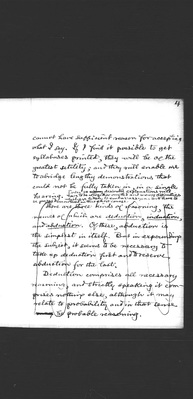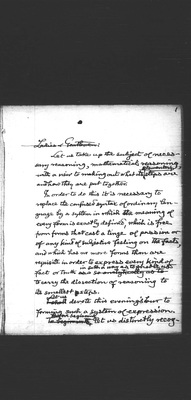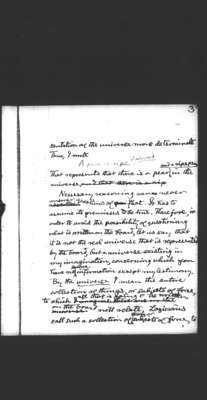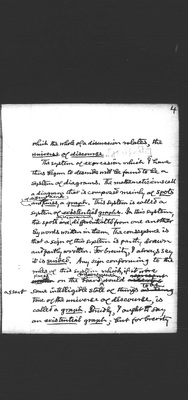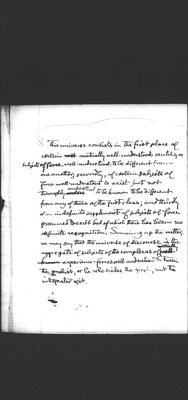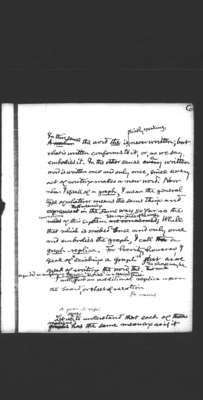Pages That Need Review
MS 447-454 (1903) - Lowell Lecture I
119
23
be equivalent to burning up the sheet since the sheet only exists, as such, in the minds of the graphist and the interpreter, and that by virtue of the agreement which the writing of the pseudograph destroys. Notwithstanding this, it is often useful to write the pseudograph in the inner close of a graph. Take this for example
Washington was a commonplace man (every assertion is false)
This say 'If Washington was a commonplace man then every assertion is false?' That is as much as to say that Washington was not a commonplace man.
Now convention No 10 is that fillinf up a close so as to leave no room in it shall be understood as inserting the pseudograph in the close. Hence in order to deny that Washington was a commonplace
120
24
man, we can write
(Washington was a commonplace man) XXXXX
or since the size of a sep is not a significant feature (Washington was a commonplace man) X
Or making the loop infintesimal we shall understand a sep as denying what id written in its close.
There are a number of important corollaries from this convention which I have not time to point out. You will easily make them out for yourselves.
It sometimes happens that lines of identity have to cross one another and produce confusion. Conventions 11 and 12 provide
155
4
cannot have sufficient reason for accepting what I say. If I find it possible to get syllabuses printed, they will be of the greatest utility; and they will enable me to abridge lengthy demonstrations that could not be fully taken in, in a single hearing. Even so desirable explanations will have to be altogether omitted and many difficulties which are likely to embarrass you will have to be passed unnoticed in this course.
MS 455-456 (1903) - Lowell Lecture II
1
To prompt you, in this short course, to any thoughts that may hereafter prove of much value to you will draw upon such abilities as mine for all that they can render. Were I dealing with a special science the case would be different. A lecturer upon electricity, for example, if he lays down a general principle, at once shows you an experiment to illustrate it. If the experiment does not fully prove the principle,
2
1
Ladies and Gentlemen:
Let us take up the subject of necessary reasoning, mathematical reasoning, with a view to making out what its elementary steps are and how they are put together.
In order to do this it is necessary to replace the confused syntax of ordinary language by a system in which the meaning of every form is exactly defined, which is free from forms that cast a tinge of passion or of any kind of subjective feeling on the facts, and which has no more forms than are requisite in order to express every kind of fact or truth so analytically as to in such a way as to enable us to carry the dissection of reasoning to its smallest steps.
I shall Let us devote this evening's hour to forming such a system of expression.
Before beginning, let us distinctly recognize
4
3
of the universe more determinate. Thus, I write
A pear is ripe
That represents that there is a pear and a ripe pear in the universe.
Necessary reasoning can never ascertain answer questions of fact. It has to assume its premisses to be true. Therefore, in order to avoid the possibility of questioning what is written on the board, let us say that it is not the real universe that is represented by the board, but a universe existing in my imagination, concerning which you have no source information except my testimony. By the universe I mean the entire collection of things, or subjects of force, to which I imagine there are in the universe all that is going to be written on the board will relate. Logicians call such a collection of things, or subjects of force, to
5
4
which the whole of a discussion relates, the universe of discourse.
The system of expression which I have thus begun to describe will be found to be a system of diagrams. The mathematicians call a diagram that is composed mainly of spots of different kinds and lines, a graph. This system is called a system of existential graphs. In this system, the spots are may be conveniently differentiated from one another by words written in them. The consequence is that a sign of this system is party drawn and partly written. For brevity, I always say it is scribed. Any sign conforming to the rules of this system which, if it were written placed on the board or sheet of assertion, would assert some intelligible state of things to be true of the universe of discourse, is called a graph. Strictly, I ought to say an existential graph; but for brevity
6
This universe consists in the first place of certain mutually well-understood centres, or subjects of force well-understood to be different from one another; secondly, of certain subjects of force well-understood to exist, but not thoroughly understood to be known to be different from any of these of the first class; and thirdly of an indefinite supplement of subjects of force presumed to exist but of which there has been no definite recognition. Summing up the matter, we may say that the universe of discourse is the aggregate of subjects of the complexus of mutually well-known experience-forces well-understood between the graphist, or he who scribes the graph, and the interpreter of it.
7
5
since existential graphs will be the only ones dealt with, I shall call it a graph, simply. For example, what I have just written scribed is a graph. The board itself is a graph, since it represents the universe as consisting of single imaginary things. The board and what is written on it together make up another graph.
We must, It is quite important, however, to distinguish between a graph and a graph replica. Suppose an editor writes to me and asks for an article of 4000 words. You know what he means by words in that case. Suppose however I say that the In what I write the single word “the” may occur twenty times on every page. Every time it will count as a separate word. Yet in another sense, it is the same word. In this latter sense, the word the consists in the sum total of general conditions to which ink-marks or voice-sounds must conform in order to be understood in a certain way.
8
6
In this sense the word the is, strictly speaking, never written; but what is written conforms to it, or, as we say, embodies it. In the other sense every a written word is written once and only once, since every act of writing makes a new word. Now when I speak of a graph, I mean the general type of whatever means the same thing and expresses that meaning in the same way so far as the rules conventions of this system are concerned take cognizance of the ways; while that which is scribed once and only once and embodies the graph, I call the a graph-replica. For brevity, however, I speak of “scribing a graph” just as we speak of writing the word the. The phrase may be defended as employing the word “scribe” in a special sense.
I will now put an additional replica upon the board, or the sheet of assertion
It rains
A pear is ripe
Let us agree to understand that each of those graphs replicas has the same meaning as if it


